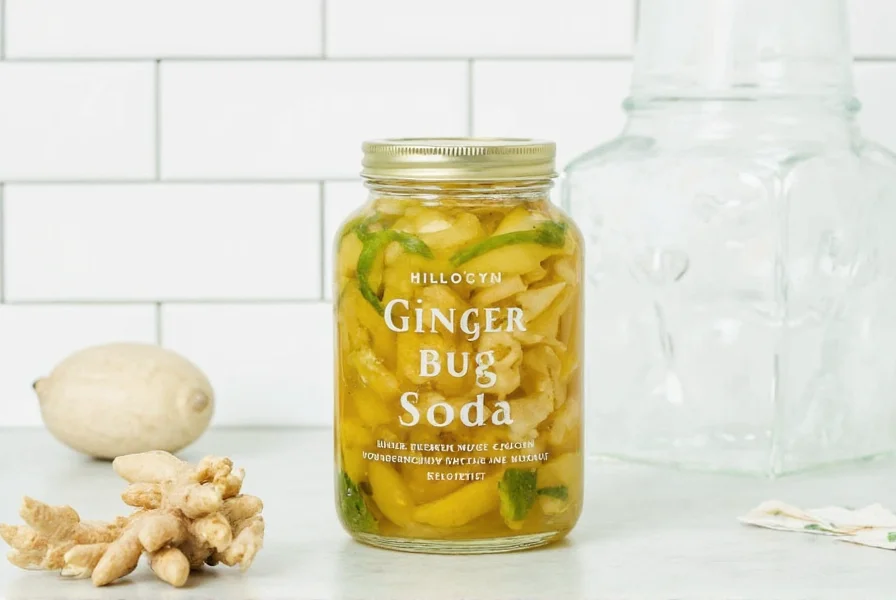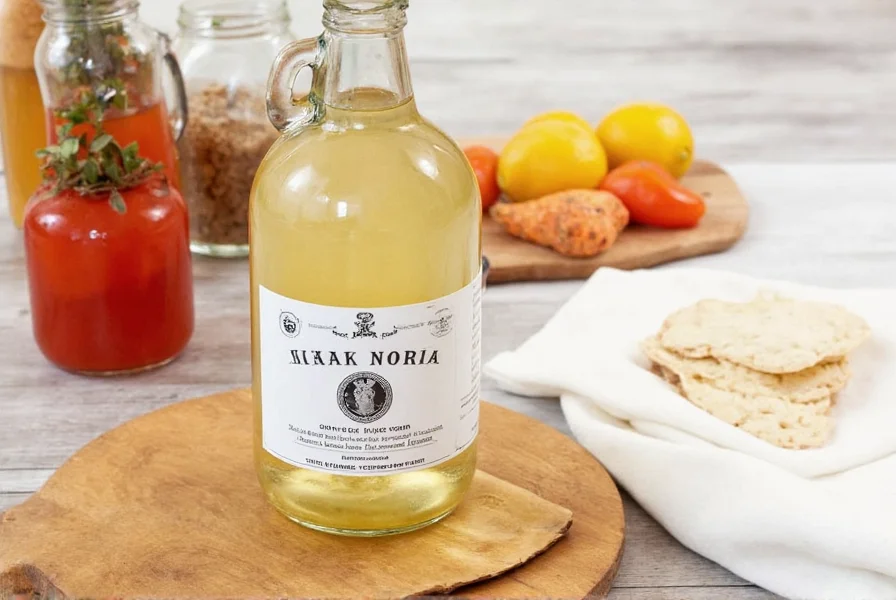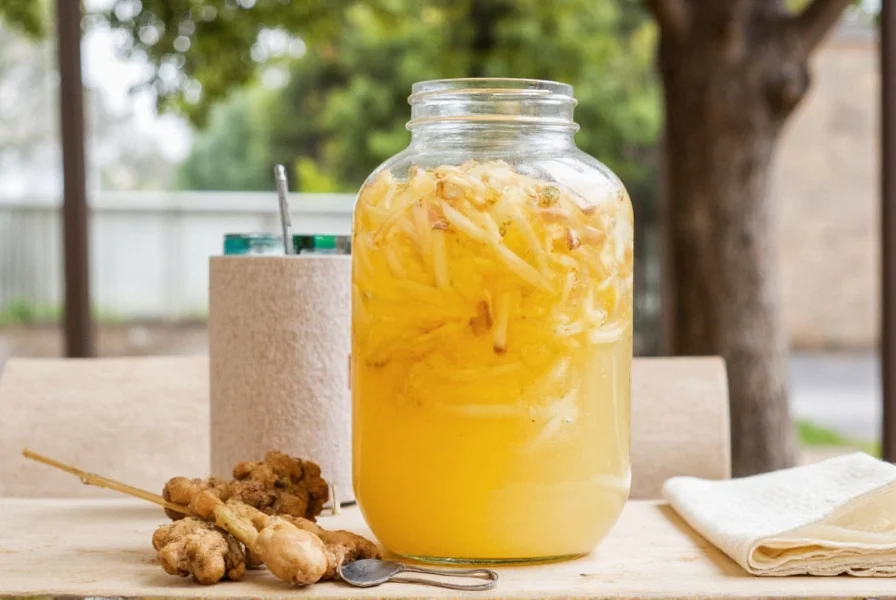The Science Behind Ginger Bug Fermentation
Ginger bug soda represents one of the simplest forms of wild fermentation accessible to home producers. Unlike commercial sodas loaded with artificial ingredients, this naturally effervescent drink harnesses wild yeast and lactic acid bacteria present on fresh ginger root. The ginger bug itself—a symbiotic culture of bacteria and yeast (SCOBY) cultivated from ginger, sugar, and water—serves as the fermentation engine that converts sugars into carbon dioxide and beneficial acids.
This traditional fermentation method creates a beverage rich in probiotics while maintaining a refreshing ginger flavor profile. The process typically takes 3-7 days depending on ambient temperature, with optimal results occurring between 68-75°F (20-24°C). During fermentation, the ginger bug consumes sugar, producing carbonation and developing complex flavor compounds that give homemade ginger soda its distinctive tang.
Creating Your Ginger Bug Starter: Step-by-Step Process
Building a healthy ginger bug requires consistency and attention to detail. Begin with organic ginger to avoid pesticides that might inhibit fermentation. Here's the proven method:
| Day | Ingredients | Process |
|---|---|---|
| 1 | 2 tbsp grated ginger, 2 tbsp sugar, 1 cup water | Combine in jar, cover with cloth, stir daily |
| 2-5 | 1 tbsp grated ginger, 1 tbsp sugar daily | Continue feeding daily, watch for bubbling |
| 6-7 | Bubbly mixture with yeasty aroma | Ready to use when consistently bubbly |
Successful ginger bug development shows visible bubbles and emits a pleasant, slightly alcoholic aroma. The culture should become increasingly active each day. If mold appears (rare with proper technique), discard and restart. This natural fermentation starter typically becomes fully active within 5-7 days when maintained at room temperature.

Transforming Ginger Bug into Sparkling Soda
Once your ginger bug demonstrates consistent activity (usually after 5-7 days of feeding), you can create the actual soda. The secondary fermentation process develops carbonation and refines flavor:
- Prepare ginger tea: Simmer 1 cup grated ginger in 4 cups water for 20 minutes
- Add 1-1.5 cups sugar (adjust to taste) and dissolve completely
- Cool to room temperature (critical step—heat kills cultures)
- Strain into clean container and add 1 cup active ginger bug
- Pour into flip-top bottles, leaving 1-2 inches headspace
- Ferment at room temperature for 2-3 days, then refrigerate
This secondary fermentation period allows carbon dioxide to build pressure in sealed bottles, creating natural carbonation. Always "burp" bottles daily during active fermentation to prevent over-pressurization. The resulting ginger bug soda contains significantly less sugar than the starting mixture, as the culture consumes most of it during fermentation.
Troubleshooting Common Ginger Bug Soda Issues
Even experienced fermenters encounter challenges with ginger bug soda. Understanding these common issues ensures consistent results:
- Flat soda: Usually indicates insufficient fermentation time or temperature too low. Extend fermentation period by 24-48 hours.
- Excessive pressure: Caused by over-fermentation or too much sugar. Always burp bottles daily and reduce sugar in next batch.
- Vinegar taste: Results from over-fermentation. Shorten secondary fermentation time by 12-24 hours.
- No bubbles in starter: Could indicate chlorinated water or non-organic ginger. Use filtered water and organic produce.
- Mold development: Rare but serious—discard immediately if any mold appears. Maintain clean equipment and proper sugar ratios.
Flavor Variations for Homemade Ginger Bug Soda
Once you've mastered the basic ginger bug soda recipe, experiment with these creative variations that maintain proper fermentation balance:
- Lemon-ginger bug soda: Add zest from 2 organic lemons during secondary fermentation
- Turmeric-ginger bug soda: Incorporate 1 tbsp grated turmeric with the ginger tea
- Berry-infused ginger bug soda: Add 1/2 cup mashed berries after primary fermentation
- Herbal ginger bug soda: Steep mint, basil, or rosemary with the ginger tea
- Tropical ginger bug soda: Substitute coconut water for 50% of the liquid
When creating flavor variations for naturally fermented ginger soda, add delicate ingredients like herbs or citrus zest during the secondary fermentation stage to preserve volatile compounds. For fruit variations, use frozen or fresh organic fruit to avoid preservatives that might inhibit fermentation.

Safety Considerations for Homemade Fermented Beverages
While ginger bug soda is generally safe when prepared correctly, follow these critical safety guidelines for successful wild fermentation:
- Always use clean, sterilized equipment to prevent contamination
- Never use metal containers—fermentation acids react with metal
- Use proper fermentation vessels with adequate headspace (at least 20%)
- Refrigerate after desired carbonation level is reached to slow fermentation
- Discard if mold appears, foul odors develop, or unusual colors emerge
- Those with compromised immune systems should consult a physician before consuming fermented foods
Properly made ginger bug soda develops a pleasantly tangy flavor with natural carbonation. The finished product typically contains less than 0.5% alcohol—similar to many fruit juices—but can reach slightly higher levels with extended fermentation. For families concerned about trace alcohol content, refrigerating after 2 days of secondary fermentation minimizes alcohol production while maintaining carbonation.
Comparing Ginger Bug Soda to Other Fermentation Methods
Ginger bug represents just one approach to natural soda fermentation. Understanding how it compares to alternatives helps determine the best method for your needs:
- Water kefir: Requires kefir grains rather than ginger bug; produces milder flavor with different microbial profile
- Whey fermentation: Uses dairy whey as starter; not suitable for dairy-free diets unlike ginger bug
- Yeast-only fermentation: Creates predictable carbonation but lacks the complex microbial diversity of ginger bug
- Commercial probiotic starters: More consistent but less traditional than wild-cultured ginger bug
The unique advantage of ginger bug soda lies in its simplicity and accessibility—requiring only ginger, sugar, and water to create a thriving culture. Unlike commercial starters, ginger bug develops a distinctive spicy flavor profile while cultivating regionally adapted wild yeast strains.
Frequently Asked Questions About Ginger Bug Soda
How long does homemade ginger bug soda last in the refrigerator?
Properly stored in airtight bottles, ginger bug soda maintains optimal flavor and carbonation for 2-3 weeks in the refrigerator. The cold temperature significantly slows fermentation while preserving probiotic content. After this period, flavor may become increasingly vinegary as fermentation continues at a reduced rate, though it remains safe to consume for several additional weeks.
Can I use honey instead of sugar when making ginger bug soda?
While some fermenters substitute honey for part of the sugar, using honey exclusively can inhibit ginger bug development. Raw honey contains antimicrobial compounds that may prevent certain beneficial bacteria from establishing. For reliable results, use cane sugar for the initial ginger bug cultivation, then experiment with honey substitutions during the secondary fermentation stage once the culture is robust and active.
Why does my ginger bug soda taste too vinegary?
Excessive vinegar flavor indicates over-fermentation, where bacteria have converted too much sugar into acetic acid. To prevent this, reduce the secondary fermentation time by 12-24 hours. Refrigerate the soda immediately once desired carbonation level is reached. For future batches, consider using less ginger bug starter (3/4 cup instead of 1 cup) or fermenting at a slightly cooler temperature to slow bacterial activity relative to yeast activity.
Is ginger bug soda safe for children to drink?
Yes, ginger bug soda is generally safe for children when prepared correctly. The trace alcohol content (typically under 0.5%) is comparable to many fruit juices. For families concerned about even minimal alcohol content, refrigerate after 2 days of secondary fermentation to minimize alcohol production while maintaining carbonation. Always introduce fermented beverages gradually to children's diets, starting with small servings to assess tolerance.
How do I know when my ginger bug is ready to use for soda making?
A ready-to-use ginger bug shows consistent bubbling throughout the mixture, emits a pleasant yeasty aroma (similar to bread dough), and typically doubles in volume within 24 hours after feeding. The culture should appear frothy and active within 4-6 hours after its daily feeding. If you see no activity after 7 days of regular feeding, restart with organic ginger and filtered water, as chlorine or pesticides may be inhibiting culture development.











 浙公网安备
33010002000092号
浙公网安备
33010002000092号 浙B2-20120091-4
浙B2-20120091-4